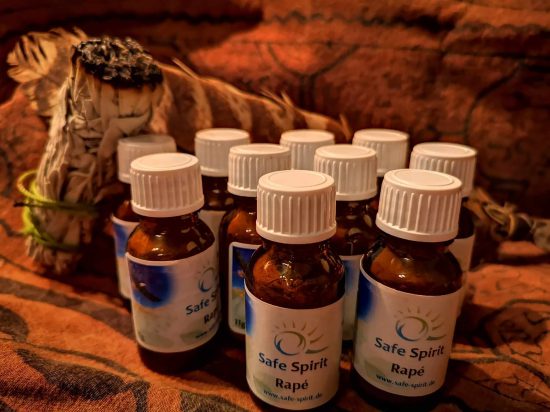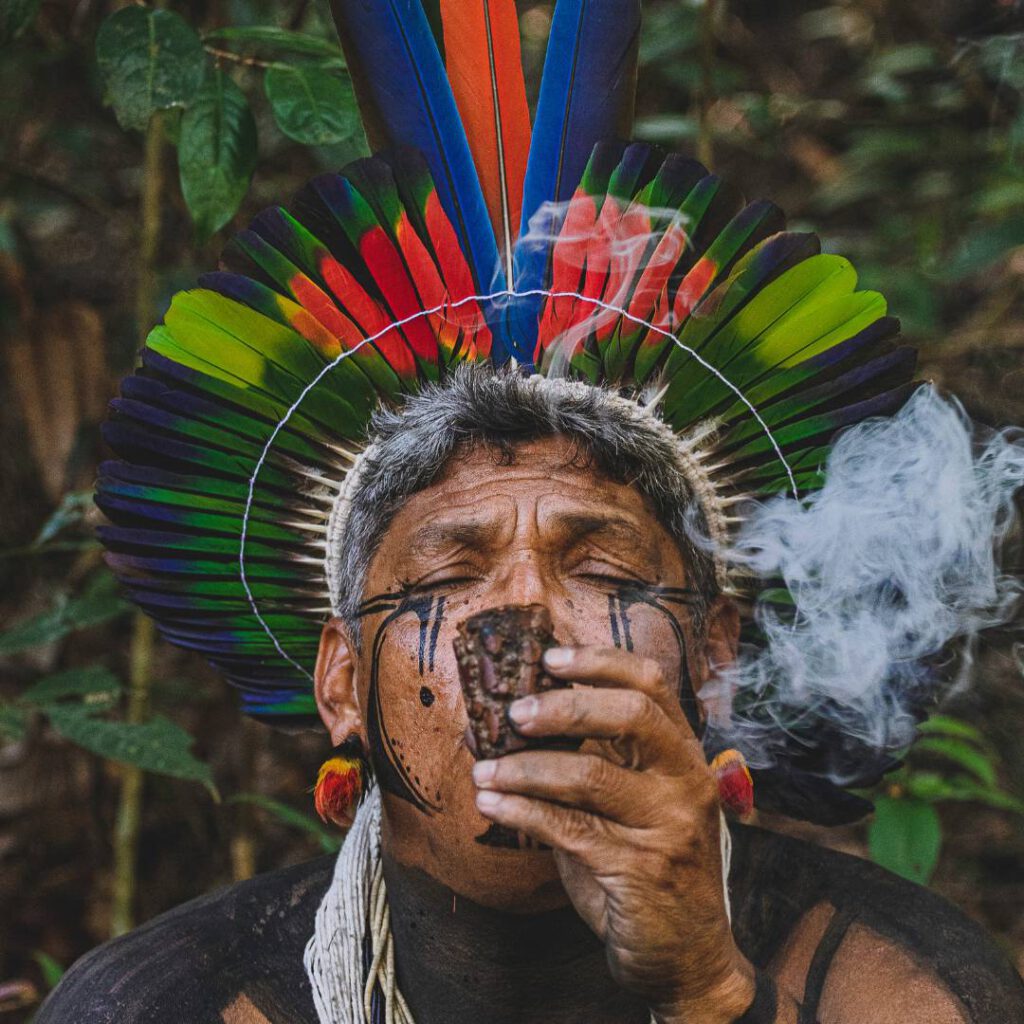Rapé shamanic snuff

Rapé
the holy Shamanic snuff
the holy Shamanic snuff
Inhalt
Rapé is a mixture of natural tobacco (nicotiana rustica or nicotiana tabacum), tree bark, and various medicinal herbs. There are over 100 different varieties of this powdery mixture. It is produced by indigenous tribes in the Amazon basin, such as the Kaxinawa, Yawanawa, or Katukina, and has been used for ritual purposes for centuries.
The powder is blown into the nostrils with a tube and serves to break blocking thought patterns and cleanse the respiratory tract and the energy field. Physical toxins and mucus are dissolved and excreted, which is particularly helpful for colds and can also lead to an improvement in the sense of smell. It also strengthens intuition and the connection to the other world. Rapé is often used in the preparation of plant ceremonies.

Cleansing:
Clearing the energy field and freeing the respiratory tract.

Access to the Otherworld:
Strengthening of intuition and opening of doors to other worlds.
Rapé snuff effects on the body and mind
Rapé works quickly, directly, and simultaneously on multiple levels—physically, mentally, emotionally, and energetically. The effect unfolds within seconds of application and can be experienced very differently depending on the blend, dosage, and personal openness. The inner attitude is also crucial: Those who use Rapé the shamanic snuff with clear intention and respect can experience profound insights, purification, and transformation.

Mental clarity and focus
Rapé has the ability to quiet the "inner noise" and place the mind into a state of heightened alertness. Many users report a sudden feeling of mental presence, clarity of thought, and mental alignment. This effect is especially helpful during meditation, prayer, vision work, or before making important decisions. Thoughts calm down, and vision becomes clear—both internally and externally.

Energetic cleansing
(physical, mental, emotional)
Rapé acts like an energetic "reset button." It helps release emotional tension, old thought patterns, or foreign energies from the body field. Rapé can support profound purification processes, especially during intense ceremonies or periods of personal transition. The purification often manifests itself on all levels: through tears, deep exhalation, yawning, or the sudden release of inner tension.

Grounding and centering
After practicing Rapé, many people report a deep sense of rootedness – like returning to their own body and the here and now. It can help them break free from mental turmoil or emotional chaos and regain clarity of self. Especially during stressful times or after intense experiences, Rapé acts as an anchor. The connection to the earth and one's own breath becomes more tangible.

Detoxification through increased salivation, nasal secretion or mild vomiting
Rapé has a powerful effect on the mucous membranes and stimulates the elimination of waste products and toxins. This can manifest itself through increased salivation, sneezing, tears, a runny nose, or even mild vomiting—which is considered a cleansing effect in a shamanic context. It can also manifest itself on an emotional level, for example, through spontaneous crying or deep feelings of relief. It is important to accept these processes and not suppress them—they serve the purpose of healing.

Meditative states and deep inner silence
After the initial cleansing process, a state of inner peace and spaciousness often occurs. Rapé can facilitate access to meditative states and lead consciousness to a deeper level. Thoughts become still, the sense of time changes, and often a space of deep intuition or inner guidance opens. Many people experience this state as particularly peaceful and healing.

Origin and History of Rapé (Shamanic Snuff)
Rapé (pronounced Ha-peh) is a shamanic snuff with deep roots in the spiritual traditions of the Amazon. For centuries, it has been used by indigenous tribes such as the Yawanawá, Huni Kuin, and Nukini—not as a stimulant, but as sacred medicine for purification, centering, and connection with nature. Rapé is traditionally used in rituals, accompanied by prayers and chants. Its use serves to clarify the mind, cleanse the energy, and prepare for other ceremonies, such as those involving Ayahuasca or Kambo. It also supports reconnection to inner wisdom and the spiritual world.
The basis of rapé is usually the strong ancient tobacco Nicotiana rustica, mixed with the ashes of sacred plants or trees such as Tsunu, Murici, or Cumaru. Each blend possesses its own energetic quality – from gentle and heart-opening to deeply cleansing and focusing.
The name “Rapé” comes from Portuguese and means “grated” or “pulverized.” However, in the cultures of origin, the blends often have their own names and are deeply connected to the identity of the respective tribe.
In recent years, Rapé has also gained importance outside of the rainforest – for example, in spiritual circles, retreats, and meditations. Careful and respectful handling of these powerful plants is essential to preserve their original depth and wisdom.

Traditional use and production of Rapé snuff
Rapé is made from finely ground tobacco (usually Nicotiana rustica, a particularly strong ancient tobacco) and the ashes of sacred plants or tree bark – such as Tsunu, Murici, Pau Pereira or Cumaru. The recipes vary depending on the tribe and region and are often passed down from generation to generation.
The preparation is a ritual process accompanied by prayers, chants, and a clear spiritual intention. The plants are carefully selected, dried, burned, and then processed into a fine powder. It is crucial that the preparation takes place in a state of inner clarity and purity, as this energy flows into the medicine.
Some tribes only produce rapé at special times—for example, during certain phases of the moon, after periods of fasting, or in preparation for sacred ceremonies. The tobacco is often dried in the sun to activate its power, and the ash comes from plants known for their purifying, protective, or heart-opening properties.
It is applied by blowing the powder into the nostrils – either independently with a kuripe (small blowpipe for personal use) or by an experienced practitioner with a tepi (longer pipe for application to another person). This process is intended to release energetic blockages, focus the mind, and strengthen the connection to spiritual realms.
Often, application is accompanied by inner silence, breathwork, or a short prayer. Many people experience a deep centering, a feeling of clarity, or the release of emotional burdens after application. Physical reactions such as tears, sneezing, increased saliva, or mild vomiting are considered part of the cleansing process.
In indigenous cultures, rapé is a tool of balance – it is used to harmonize the body, clear the mind, and connect with one’s spiritual guidance. Although the effect is often immediate, rapé also works subtly – it can bring insights that only become apparent later in everyday life.
In ceremonies, rapé is sometimes used multiple times – at the beginning for cleansing, in between for grounding, or at the end for integration. It is always treated with respect, as a living medicine that should be received with awareness and humility.
Rapé snuff in contemporary times and modern society
In recent years, rapé tobacco has also gained popularity outside of the Amazon region. More and more people are using this shamanic snuff as a supportive tool for meditation, ceremonies, or self-reflection. In Europe and North America, rapé has become part of a growing movement surrounding neo-shamanism, plant medicine, and spiritual self-healing. A conscious and respectful approach to this sacred medicine is essential to avoid cultural appropriation and preserve its profound spiritual impact. Many spiritually inclined people discover rapé as a powerful means of centering and grounding in hectic everyday life. In urban spaces, it is often used in rapé ceremonies, women’s or men’s circles, retreats, or as part of personal mindfulness practices. The effect of rapé is often described as an energetic “reset” that promotes mental clarity and inner peace. At the same time, it is important to respect the original origins and meaning of rapé snuff and not to imitate it superficially. Therefore, more and more people are seeking authentic guidance, experiential spaces, and deeper knowledge about the use of rapé. This development shows that rapé has the potential to be an important tool for inner alignment and spiritual practice today – provided it is used mindfully.Scientific Studies on Rapé snuff
Although its traditional use is well documented, there have been few scientific studies on rapé to date. Some studies focus on the ingredients of Nicotiana rustica, the powerful original tobacco that forms the basis for many rapé blends. Compared to commercially available tobacco, it has a significantly higher nicotine content. Initial studies indicate possible neuroactive effects – such as promoting alertness, concentration, and mental clarity. The combination of plant ash and tobacco appears to have specific effects on the nervous system. At the same time, there have been hardly any systematic long-term studies on its effects on health, brain chemistry, or emotional processing. The subjectively reported spiritual experiences that many users associate with rapé snuff are also largely unexplored scientifically. Research approaches from ethnobotany and psychology are increasingly advocating for an integrative perspective that also takes indigenous perspectives into account. A particularly exciting approach would be to investigate the interaction between plant components and their effects on consciousness and intuition in greater depth. In the long term, it would be desirable to conduct studies with interdisciplinary teams – in collaboration with indigenous communities that possess centuries-old knowledge. Only in this way can the shamanic snuff Rapé be fully understood from a modern perspective.Buying Rapé snuff – What You Should Consider
If you want to buy Rapé, it is crucial to pay attention to quality, origin, and ethical sourcing. Rapé is not an ordinary snuff, but a spiritual herbal medicine with deep cultural significance. Those seeking original Rapé blends produced by indigenous producers should choose carefully and ensure the transparency of their suppliers.Important criteria when purchasing:
- Handmade products from an indigenous context with documented origins
- Transparent production without additives or chemicals
- Fair trade relations with the tribes and support for local communities
- Fresh, natural ingredients and purity of the powder
Avoid products that are not clearly labeled or do not provide information about their origins. High-quality rapé usually comes in small batches, carefully packaged, and produced with spiritual intent. Some suppliers work directly with shamans or tribal families—an important sign of quality and authenticity. If you are unsure, ask specifically: Where does the mixture come from? Who produced it? Which tribe is behind it? A conscious purchase is not only a personal investment in your well-being, but also an act of appreciation for indigenous wisdom.
FAQ - Rapé shamanic snuff
Are you interested in rapé, the shamanic snuff from the Amazon, and would like to learn more about its use, effects, and origins? In this FAQ, we answer the most frequently asked questions about rapé – from traditional rituals and spiritual significance to safe and conscious use. Whether you’re a beginner or experienced user, you’ll find concise and well-founded information here to guide you.
Rapé is a shamanic snuff from the Amazon region, consisting of finely ground Nicotiana rustica (ancient tobacco) and the ashes of sacred plants. It is traditionally used by indigenous peoples for purification, grounding, and spiritual alignment.
Rapé has a clarifying, grounding, and energetically cleansing effect. Users report mental clarity, emotional relief, and deep inner peace. The effect depends on the composition, dosage, and intention.
Rapé is blown into the nostrils using a blowpipe (kuripe or tepi). It is traditionally performed while seated, with a focus on breathing, mindfulness, and spiritual alignment. The effect usually begins within a few seconds.
Yes, Rapé tabocca is legal in most countries – including Germany, Austria, and Switzerland – because it doesn’t contain any psychoactive substances in the legal sense. However, its cultural and spiritual background should be respected.
Rapé can be purchased online from specialized shops that work with indigenous communities. Look for ethically sourced rapé blends, transparent origins, and pure ingredients without additives.
There are numerous varieties of rapé, depending on the plant material used and the strain of origin. Popular ones include Tsunu Rapé, Murici Rapé, Cumaru Rapé, and Nukini Rapé – each blend has its own energetic signature and effect.
Yes, but the introduction should be done carefully and with respect. Beginners should start with mild blends and ideally be accompanied by an experienced person or in a ritual setting.
Temporary side effects may include watery eyes, sneezing, nausea, or mild vomiting—this is considered part of the cleansing process. Rapé should not be used if pregnant, suffering from high blood pressure, or heart problems.
The frequency depends on individual needs and personal practice. Some people use rapé snuff daily in small doses, others only on special occasions or in ceremonies. The important thing is the intention and conscious use.
A kuripe is a V-shaped blowpipe used for personal use, connecting the mouth and nose. A tepi is a longer blowpipe used to administer rapé to another person—usually in shamanic ceremonies.
Medical Disclaimer
The information on Rapé snuff provided on this page is intended solely for spiritual, cultural, and educational purposes. Rapé snuff is a traditional plant medicine used ritually in indigenous contexts – however, it is not a substitute for medical or psychotherapeutic treatment. If you have existing physical or mental illnesses, especially cardiovascular problems, high blood pressure, epilepsy, or pregnancy, you should definitely seek medical advice before use. The effects of Rapé snuff can vary greatly from person to person.
Disclaimer
The use of Rapé snuff is at your own risk. We assume no liability for any physical, psychological, or legal consequences that may arise from the use or misuse of these snuffs. Please inform yourself thoroughly about the origin, effects, and responsible use before using Rapé snuff. Every person is unique – what is supportive for one person may be inappropriate for another. Mindfulness, respect, and personal responsibility are key requirements when dealing with these powerful plants.
